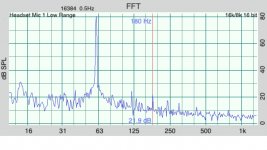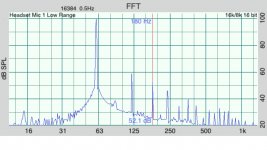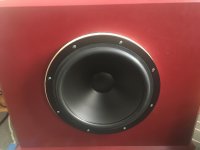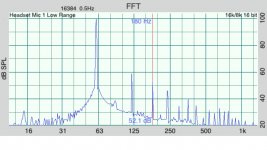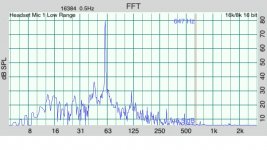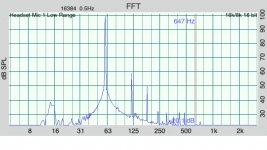ajc9988, unfortunately I sold off the dayton rs subwoofer long ago to fund the purchase of some of the other drivers. This is before I started to do IMD testing.
This italian speaker website Sub-woofer, Peerless, Seas, Scan-speak has distortion graphs of the 4 ohm version of the SB and the Dayton rs 8 as well. Based on the graphs it looks like the SB has lower harmonic distortion.
IMD is partially caused by the variation of inductance over excursion I think the dayton might do better in this regard due to the mention of shorting rings in the magnet structure, which I don't believe the SB has.
As far as comparing the 12s the dayton has a high suspension loss value (RMS) which german diy speaker magazines says causes a loss of detail in bass. I think the I hear this in the dayton and heard more detail with the SB.
This italian speaker website Sub-woofer, Peerless, Seas, Scan-speak has distortion graphs of the 4 ohm version of the SB and the Dayton rs 8 as well. Based on the graphs it looks like the SB has lower harmonic distortion.
IMD is partially caused by the variation of inductance over excursion I think the dayton might do better in this regard due to the mention of shorting rings in the magnet structure, which I don't believe the SB has.
As far as comparing the 12s the dayton has a high suspension loss value (RMS) which german diy speaker magazines says causes a loss of detail in bass. I think the I hear this in the dayton and heard more detail with the SB.
@shrub0
Recommendations for (a retirement) future sub project(s)?
My strong long time interest in the Dayton reference 8 ohm 12” for my home Theatre has been:
a. atypical low F3 modeling to 20-21hz compared to every other 12” and MANY 15” drivers.
b. from (comparatively) small 4.7cu ft ported closure
c. believed by me to deliver higher fidelity and near-equal* performance over many other 12” subs to include Dayton’s own 12” Ultimax* driver....
...and all at a lower price than most if not all other 12”-15” subs. If some could advise me how to go about using DSP for the same F3 from a slightly smaller** ported closure I’d be very grateful.
**just under 4 cu ft?
I said all that to say this I’d pay a bit more for the same F3 and higher fidelity. I plan to build three for sure. Two band limited low passed ~40hz. The third’s primary function: the LFE channel. Secondary: center channel’s bass below ~80hz. The 4* Surrounds: each will have a dedicated smallish sub good to the mid 20s depending upon room gain though if they can’t deliver match their output, I’ll either pair two surrounds w/single sub or build them each their own.
* presently 2; 4 upon relocation in to larger room.
Thanks for your recommendations, patience, and reading this far...
Tony
Recommendations for (a retirement) future sub project(s)?
My strong long time interest in the Dayton reference 8 ohm 12” for my home Theatre has been:
a. atypical low F3 modeling to 20-21hz compared to every other 12” and MANY 15” drivers.
b. from (comparatively) small 4.7cu ft ported closure
c. believed by me to deliver higher fidelity and near-equal* performance over many other 12” subs to include Dayton’s own 12” Ultimax* driver....
...and all at a lower price than most if not all other 12”-15” subs. If some could advise me how to go about using DSP for the same F3 from a slightly smaller** ported closure I’d be very grateful.
**just under 4 cu ft?
I said all that to say this I’d pay a bit more for the same F3 and higher fidelity. I plan to build three for sure. Two band limited low passed ~40hz. The third’s primary function: the LFE channel. Secondary: center channel’s bass below ~80hz. The 4* Surrounds: each will have a dedicated smallish sub good to the mid 20s depending upon room gain though if they can’t deliver match their output, I’ll either pair two surrounds w/single sub or build them each their own.
* presently 2; 4 upon relocation in to larger room.
Thanks for your recommendations, patience, and reading this far...
Tony
Tony, personally I'd go sealed with the daytons they are pretty clean already in the low bass and then you won't have to worry about port chuffing and resonances. If you can afford 2 drivers, dual dayton rs 12s sealed would make a nice home theater sub. They only need 2.1 cu ft but 3cu ft in total would be better. But building three separate boxes like you said and spreading them out around the room would give the flattest response.
If you look at page 1 of this thread the dual 12 has more average output at 5% distortion than the passive radiator single 12.
I haven't found another 12 as clean as the dayton from 16hz-40hz. However, I'm more of a music guy and I didn't like how the dayton did in the upper bass, for example kick drum sounded sluggish. This might be due to a design tradeoff of a relatively heavy moving mass so it can do low bass in a small box.
However if your mains can handle a low crossover this is a non-issue. Just crossover at 50hz or so. I believe most quick impulses like from a kick drum are occurring above 40-50hz.
If you look at page 1 of this thread the dual 12 has more average output at 5% distortion than the passive radiator single 12.
I haven't found another 12 as clean as the dayton from 16hz-40hz. However, I'm more of a music guy and I didn't like how the dayton did in the upper bass, for example kick drum sounded sluggish. This might be due to a design tradeoff of a relatively heavy moving mass so it can do low bass in a small box.
However if your mains can handle a low crossover this is a non-issue. Just crossover at 50hz or so. I believe most quick impulses like from a kick drum are occurring above 40-50hz.
Last edited:
Great information and thank you for doing all the work you have in this regard.ajc9988, unfortunately I sold off the dayton rs subwoofer long ago to fund the purchase of some of the other drivers. This is before I started to do IMD testing.
This italian speaker website Sub-woofer, Peerless, Seas, Scan-speak has distortion graphs of the 4 ohm version of the SB and the Dayton rs 8 as well. Based on the graphs it looks like the SB has lower harmonic distortion.
IMD is partially caused by the variation of inductance over excursion I think the dayton might do better in this regard due to the mention of shorting rings in the magnet structure, which I don't believe the SB has.
As far as comparing the 12s the dayton has a high suspension loss value (RMS) which german diy speaker magazines says causes a loss of detail in bass. I think the I hear this in the dayton and heard more detail with the SB.
How accurate are the spec sheets on the rolloff on the low end?
Specs sheets sometimes say measurements conditions, sometimes they don't. I'd be weary if they don't. It should pretty well match what you model in winisd if you input a huge box. The italian website uses a baffle flush mounted in the wall. So as you probably know you will get a different response in a box. More info on their measurement conditions here: Archivio altoparlanti
i agree! But there’s more to it than that. 4/5 channels have dedicated subs. The “center’s sub” doubles as the LFE. I want to “up the ante” for the mains and LFE/center....building three separate boxes like you said and spreading them out around the room would give the flattest response.
perfect to cover the the last octave of the mains. But “sounds”like I need a different driver for the LFE. I understand it’s bandwidth is below 20hz to 120hzI haven't found another 12 as clean as the dayton from 16hz-40hz.
me too. My mains do music well. Need a dual purpose system due to lack of space.However, I'm more of a music guy...
Mains are musical and their rated F3 35 hz. W/room gain, F3 31 hz.However if your mains can handle a low crossover this is a non-issue.
Your estimated Kick and bass guitar cut off are spot on!I believe most quick impulses like from a kick drum are occurring above 40-50hz.
A couple things I just learned from got me thinkin’:
$170-200 for a driver.
$300 the bare minimum for an amp.
$100 Materials to build and finish the closure
A new HSU VTF-2 Mk or SVS PB-1000 pro:
meets my sonic requirements
a smaller footprint
comes already built
for about the same money💰.
I’ve looked forward to retirement to DIY subs for years. I hafta ask is all the trouble worth it? I’m sorry for your wasting your time.
Thank you for your knowledge and efforts
Tony, I don't have much experience with commercial subs but here's a writeup and measurements of a CSS SDX12 (CSS SDX12 Subwoofer Measurements and Analysis | Audioholics) diy sub and a SVS SB3000 (SVS 3000 Series Subwoofer Measurements and Conclusion | Audioholics).
Comparing the sealed options the CSS has more output in the low bass and the SVS has more upper bass. You could probably save $200 by going the DIY route. I'm finding low IMD distortion to be a better indication of how a subwoofer actually sounds and I don't have data on either of these two.
I'm on the lookout for a used CSS SDX12 however.
Comparing the sealed options the CSS has more output in the low bass and the SVS has more upper bass. You could probably save $200 by going the DIY route. I'm finding low IMD distortion to be a better indication of how a subwoofer actually sounds and I don't have data on either of these two.
I'm on the lookout for a used CSS SDX12 however.
Thanks for everyone's input. I've been building speakers for 22 years and since it's a hobby and have other responsibilites I design in simulation software and then months sometimes years later I am able to hear my results.
What's different about this "project" is that I have a solid enclosure with t-nuts and a passive radiator and with the help of some used sub purchases, I can change a driver and go from sealed to passive radiator in a matter of minutes. Playing the same song 5 minutes later I can hear a difference in subs.
Yes the sound of a subwoofer is dictated by the room, but keeping the room constant and the variable the sub I can hear large differences in the sound quality of different subs.
I have spent many hours scouring forums reading about the importance of low flux modulation, how moving mass doesn't matter, how some say a low RMS suspension value is important. How group delay in the lowest frequency doesn't matter etc... I also enjoyed an article on DIYMA on how a horn subwoofer sounds tight because although there is a 90 degree phase lag and a delay in the horn path, the phase lag is fairly constant in the operating range and thus the fundamental of a kick drum at 50hz and it's harmonic at 100hz have similar phase and group delay and they sound pleasing to the ear (thanks Patrick Bateman). I think I hear this with my horn loaded subs.
All the information on forums is interesting but what I do trust is my ears I was a bass player in the orchestra in high school and college and enjoy music from sun up to sun down. What I can tell you is this, the dayton reference subs look great on paper but sound like mush to me. Manufactured supplied xmax really isn't that useful. I got way more output at low distortion with the reference sub with 14mm xmax that the ultimax with 19mm xmax.
Hi, i just read through your entire thread and really enjoyed your journey. i have 4x mag 12 and i definitely agree with you on the fun factor of these speakers, they do really well with rock and punchy bass and kick drums.
i've been researching the secret sauce of drivers for a while, and like you, have come up with a few key parameters that seem to correlate well and differentiate these drivers. In fact, the drivers you tested are all in my short list.
High ish Qms seems important, more than 5-8 is good. >10 is rare and seems to be really on the mag 12 that i've heard.
Low Rms seems to be just as important, if not even more important than the high Qms. You list of driver reads like my short list - Lab 12, NE315. Peerless XXLS12. Mag 12, all have outstandingly low RMS.
One other factor i didn't see you mention has to do with motor strength. Commonly calculated as BL2/Re. This was described by Lawrence Dickie in an interview. When they did the Vivid G1S with the new stronger motor, and then used the same stronger motor in the G2 and G3, they found subjectively better sounding bass with the stronger motor. Lawrence Dickie called it Shove. If you further divide the Shove (BL2/Re) with MMS to represent the relative acceleration of the drive, then again the pack spreads out and Mag 12 stands out as one of the drivers with good acceleration, low Rms and high Qms.
Lastly, and this was described by the guys over at DIYSoundgroup, has to do with the impedance peak of the driver. It draws very little power at the resonance peak and is ultra efficient. For the mag 12 in a sealed cab, its resonance peak is in the 60hz range where the kick drum energy resides. So it can deliver kick drum peaks with no effort and compression because it draws hardly any power in that range.
While for a driver like RSS315 or UM12, the resonance peak is low (less efficient) and also at a lower frequency (30-40hz range). So it's characteristic sound is that low bass (40hz) heft and authority due to its resonance peak.
Sorry for the long post. i was really excited to find a kindred spirit on the same path as myself.
Looking forward to more data from your testing!
Tony, personally I'd go sealed with the daytons they are pretty clean already in the low bass and then you won't have to worry about port chuffing and resonances. If you can afford 2 drivers, dual dayton rs 12s sealed would make a nice home theater sub. They only need 2.1 cu ft but 3cu ft in total would be better. But building three separate boxes like you said and spreading them out around the room would give the flattest response.
If you look at page 1 of this thread the dual 12 has more average output at 5% distortion than the passive radiator single 12.
I haven't found another 12 as clean as the dayton from 16hz-40hz. However, I'm more of a music guy and I didn't like how the dayton did in the upper bass, for example kick drum sounded sluggish. This might be due to a design tradeoff of a relatively heavy moving mass so it can do low bass in a small box.
However if your mains can handle a low crossover this is a non-issue. Just crossover at 50hz or so. I believe most quick impulses like from a kick drum are occurring above 40-50hz.
i'm being greedy in that i want both the low bass and the midbass strengths that both drivers offer. But i don't want to introduce yet another crossover in the bass. Once could conceivably run both drivers, RSS315 and Mag 12 in the same pass band, and with appropriate placement / delay / EQ get them to sum across the pass band with no cancellation.
Viola, more output from using 2 drivers, but more importantly, having the midbass punch of the Mag 12 and the low bass authority of the RSS315 all in the same package.
What is your opinion, then, of the scanspeak 30w/4558T00? Price wise, it comes in cheaper than the CSS, seems to be more sensitive, specs look good, etc.Tony, I don't have much experience with commercial subs but here's a writeup and measurements of a CSS SDX12 (CSS SDX12 Subwoofer Measurements and Analysis | Audioholics) diy sub and a SVS SB3000 (SVS 3000 Series Subwoofer Measurements and Conclusion | Audioholics).
Comparing the sealed options the CSS has more output in the low bass and the SVS has more upper bass. You could probably save $200 by going the DIY route. I'm finding low IMD distortion to be a better indication of how a subwoofer actually sounds and I don't have data on either of these two.
I'm on the lookout for a used CSS SDX12 however.
I just haven't seen much talk about it, and modeling in a box of 5.5ft^3, 18.5Hz, vent of 1.63x14x28.56in (box roughly 14"x28"x34" after vent, bracing, and insulation, or 1.4x the volume in winISD), with a HPF of LR4@11Hz, LPF of LR4@120Hz, PEQ of 20Hz, Q=5, gain=1db, PEQ=55Hz, Q=1.4, gain=-0.5dB, with system input power at 138W to match the other speaker's RMS and simulating voice coil inductance, I get a really nice response.
Considering I'm planning on putting the subs in tower speakers, not one sub or two separate around the room (although that could change with my design), and the selected amp has lower wattage rms, so cannot push the CSS loud, and using DSP with an active crossover, ...
rhapsodee,
Thanks for your input. It's interesting that you are realizing some of the same things on the other side of the world. A local guy is planning to use 4 magnums in a build, 2 per side. Maybe you can give some details on crossover and port tuning if you used ports.
I've also been looking into bl^2/Re. I've also taken that a step further and divided this number by the moving mass. Some call this the acceleration factor and it seems to be a very debatable topic if it's a meaningful number or not if you research old forum posts. However drivers I consider to be snappy such as the diysg magnum consistently have a high value.
Thanks for your input. It's interesting that you are realizing some of the same things on the other side of the world. A local guy is planning to use 4 magnums in a build, 2 per side. Maybe you can give some details on crossover and port tuning if you used ports.
I've also been looking into bl^2/Re. I've also taken that a step further and divided this number by the moving mass. Some call this the acceleration factor and it seems to be a very debatable topic if it's a meaningful number or not if you research old forum posts. However drivers I consider to be snappy such as the diysg magnum consistently have a high value.
ajc9988,
Sorry it took a while for me to answer your question. I have no personal experience with the scanspeak 30w/4558T00. Here's some tests that have some other drivers I've tested so you could do a comparison Sub-woofer, Peerless, Seas, Scan-speak.
It looks like harmonic distortion is higher than the eminence lab 12 and Dayton Audio RSS315HFA-8. However, I'm finding IMD to be a better indication of how clean the driver sounds. I believe this driver is a similar platform to the peerless XXLS and the XXLS did really well in IMD testing.
I have the scanspeak 30w passive radiator and it works well.
Sorry it took a while for me to answer your question. I have no personal experience with the scanspeak 30w/4558T00. Here's some tests that have some other drivers I've tested so you could do a comparison Sub-woofer, Peerless, Seas, Scan-speak.
It looks like harmonic distortion is higher than the eminence lab 12 and Dayton Audio RSS315HFA-8. However, I'm finding IMD to be a better indication of how clean the driver sounds. I believe this driver is a similar platform to the peerless XXLS and the XXLS did really well in IMD testing.
I have the scanspeak 30w passive radiator and it works well.
The GRS sub is good for the price. But the IMD distortion is telling that as the music gets complex and loud the distortion gets high. Attached is the IMD distortion of the GRS playing 30hz and 72hz at once at 70db. I noticed this with listening some songs sounding clean but others muddy. Having multiple subs cuts down on distortion to some extent and isobaric would cut down even order distortion.
I see some people are using these outdoors as patio subs. With a poly cone and rubber surround this would be a fun application.
Perhaps the isoberic configuration reduces distortion? No doubt the single driver on its own is lousy. Price wise it seemed worth a shot so I built a 6 cubic foot proof of concept enclosure with a rather large port to tune it around 21-22 hz. To put it mildly the device shook my neighbors house and sounded very clean running on a 300w amp wired in parallel, 60hz active crossover. Bass guitars in particular sound extraordinary. I would really like to see how it looks "on paper" though. Any chance you can try it out on your test setup?
Last edited:
Ploppythirds, yes isobaric reduces even order harmonic distortion 2nd, 4th etc. but leaves the odd order harmonic distortion 3rd,5th etc. which some find more offensive. I'm not sure if even order IMD is also reduced. Anyone care to comment? Maybe I found a new experiment.
Next up in the test box is a Audio Technology Flexunits 12 B 77 25 10. Audio Technology is a diy speaker builders dream as they can tailor their speakers to your specifications, as long as you stay within the laws of physics.
This speaker I found out does a lot better in vented alignments but for consistency I will post the sealed box results. However, when within it's limits this driver has a super clean sound. It's low IMD levels are a good representation of this.
Here's the max spl at 5% distortion measurements:
Frequency Spl of fundamental 2nd harmonic 3rd harmonic
16 66 -35 -24
20 68 -27 -24
25 66 -25 -29
31.5 61 -21 -32
40 89 -24 -39
50 109 -22 -26
63 112 -26 -30
attached is 60hz @80db and 100 db
This speaker I found out does a lot better in vented alignments but for consistency I will post the sealed box results. However, when within it's limits this driver has a super clean sound. It's low IMD levels are a good representation of this.
Here's the max spl at 5% distortion measurements:
Frequency Spl of fundamental 2nd harmonic 3rd harmonic
16 66 -35 -24
20 68 -27 -24
25 66 -25 -29
31.5 61 -21 -32
40 89 -24 -39
50 109 -22 -26
63 112 -26 -30
attached is 60hz @80db and 100 db
Attachments
Last edited:
Wow, very nice. Can you share some subjective comments on the sound quality of the Audio tech flex 12?
Also I noticed the XXLS 10 did extremely well on the IMD rank, but you didn't post individual HD measurement results or subjective listening impressions. The XXLS 12 also has one of the lowest Rms specs around.
Given how you found the Dayton RSS315 to have the most authoritative low bass, what do you think about a dual driver bass module? A RSS315 for the low bass, and a Mag12 or SB34 for the upper bass. Both playing the same bass passband, but each contributing their characteristic strength in the bass.
Also I noticed the XXLS 10 did extremely well on the IMD rank, but you didn't post individual HD measurement results or subjective listening impressions. The XXLS 12 also has one of the lowest Rms specs around.
Given how you found the Dayton RSS315 to have the most authoritative low bass, what do you think about a dual driver bass module? A RSS315 for the low bass, and a Mag12 or SB34 for the upper bass. Both playing the same bass passband, but each contributing their characteristic strength in the bass.
I, too, am on the lookout for two CSS SDX12s on sale or used.Tony, I don't have much experience with commercial subs but here's a writeup and measurements of a CSS SDX12 (CSS SDX12 Subwoofer Measurements and Analysis | Audioholics) diy sub and a SVS SB3000 (SVS 3000 Series Subwoofer Measurements and Conclusion | Audioholics).
Comparing the sealed options the CSS has more output in the low bass and the SVS has more upper bass. You could probably save $200 by going the DIY route. I'm finding low IMD distortion to be a better indication of how a subwoofer actually sounds and I don't have data on either of these two.
I'm on the lookout for a used CSS SDX12 however.
A little PEQ gets it down to 20hz; reasonable foot print, sealed to boot keeps things simple. 4th order LR LP’d around 40hz will do the trick for my L&R channels. I just PU a Sunfire* True Subwoofer Signature for LFE duties at such a fantastic price I couldn’t resist.
*not the newer EQ version
I thank you so much for your patience and knowledge.
Now for the Audio Technology in the 38hz tuned 85 liter alignment. This is the right driver if you are looking for detail in the bass. For example my family enjoys the Hamilton musical so I've heard the soundtrack hundreds of times. In the song the story of tonight, I've always heard bass but wasn't sure if it was a keyboard or some synth bass, after playing the song through this woofer I discovered that there is a cello and upright bass in this song and I can now hear the texture of the string.
Personally I'd go with a lower tuning than 38hz but the audio technology seems to play super clean at low excursions and the port helps with that, and from 25-63hz this is probably the loudest average spl at 5% distortion. The seasl26 takes over at 40hz but the Audio Technology has 5 more db at 25hz.
Here's the max spl at 5% distortion measurements:
Frequency Spl of fundamental 2nd harmonic 3rd harmonic
16 56 -31 -20
20 66 -47 -26
25 90 -26 -25
31.5 94 -24 -26
40 94 -25 -33
50 110 -25 -42
63 112 -30 -47
attached is 60hz @80db and 100 db
Personally I'd go with a lower tuning than 38hz but the audio technology seems to play super clean at low excursions and the port helps with that, and from 25-63hz this is probably the loudest average spl at 5% distortion. The seasl26 takes over at 40hz but the Audio Technology has 5 more db at 25hz.
Here's the max spl at 5% distortion measurements:
Frequency Spl of fundamental 2nd harmonic 3rd harmonic
16 56 -31 -20
20 66 -47 -26
25 90 -26 -25
31.5 94 -24 -26
40 94 -25 -33
50 110 -25 -42
63 112 -30 -47
attached is 60hz @80db and 100 db
Attachments
Last test for the Audio Technology is a 85liter 17hz passive radiator alignment. Too low a tuning to add much output but nevertheless in general I really enjoy listening to this driver, in fact this has been what I put back in my test box in between driver testing.
I'd like to clear up two misconceptions I had with this driver. It has a very compliant excursion suspension (CMS) so I was worried about it easily bottoming out. However, there is a very high xmech (24mm) so in practice even with high listening levels I haven't been able to bottom it out. Also, it uses a poly cone and maybe some have experienced the mushy sound of a poly cones. This driver shows no sign of this, I would describe it as clean and detailed. My subjective description of clean sound is documented objectively by low IMD in post #199.
Here's the max spl at 5% distortion measurements:
Frequency Spl of fundamental 2nd harmonic 3rd harmonic
16 66 -25 -41
20 82 -31 -24
25 75 -25 -28
31.5 50 -20 -31
40 86 -25 -41
50 109 -24 -33
63 112 -32 -37
attached is 60hz @80db and 100 db
I'd like to clear up two misconceptions I had with this driver. It has a very compliant excursion suspension (CMS) so I was worried about it easily bottoming out. However, there is a very high xmech (24mm) so in practice even with high listening levels I haven't been able to bottom it out. Also, it uses a poly cone and maybe some have experienced the mushy sound of a poly cones. This driver shows no sign of this, I would describe it as clean and detailed. My subjective description of clean sound is documented objectively by low IMD in post #199.
Here's the max spl at 5% distortion measurements:
Frequency Spl of fundamental 2nd harmonic 3rd harmonic
16 66 -25 -41
20 82 -31 -24
25 75 -25 -28
31.5 50 -20 -31
40 86 -25 -41
50 109 -24 -33
63 112 -32 -37
attached is 60hz @80db and 100 db
Attachments
rhapsodee, To answer your question the xxls 10" is actually the driver that I've had for the longest and is the driver that started me down a quest for clean bass.
All in all it's a nice clean sounding driver but when low bass gets loud it seems there is too much momentum of the 134gram cone so that the decay is still noticeable between notes. I experienced something similar with the Seas 10. Maybe a 12" xxls would be better since there would be less excursion for a given spl and the 12" XXLS 830517 actually has slightly less MMS at 131g. As you probably know Peerless has changed to Tymphany and I've tried to contact Tymphany about their drivers that might be good for my test and I never got a reply. Maybe someone has a contact email?
All in all it's a nice clean sounding driver but when low bass gets loud it seems there is too much momentum of the 134gram cone so that the decay is still noticeable between notes. I experienced something similar with the Seas 10. Maybe a 12" xxls would be better since there would be less excursion for a given spl and the 12" XXLS 830517 actually has slightly less MMS at 131g. As you probably know Peerless has changed to Tymphany and I've tried to contact Tymphany about their drivers that might be good for my test and I never got a reply. Maybe someone has a contact email?
- Home
- Loudspeakers
- Subwoofers
- A tale of 12" subwoofers, distortion and 15 dollars.
